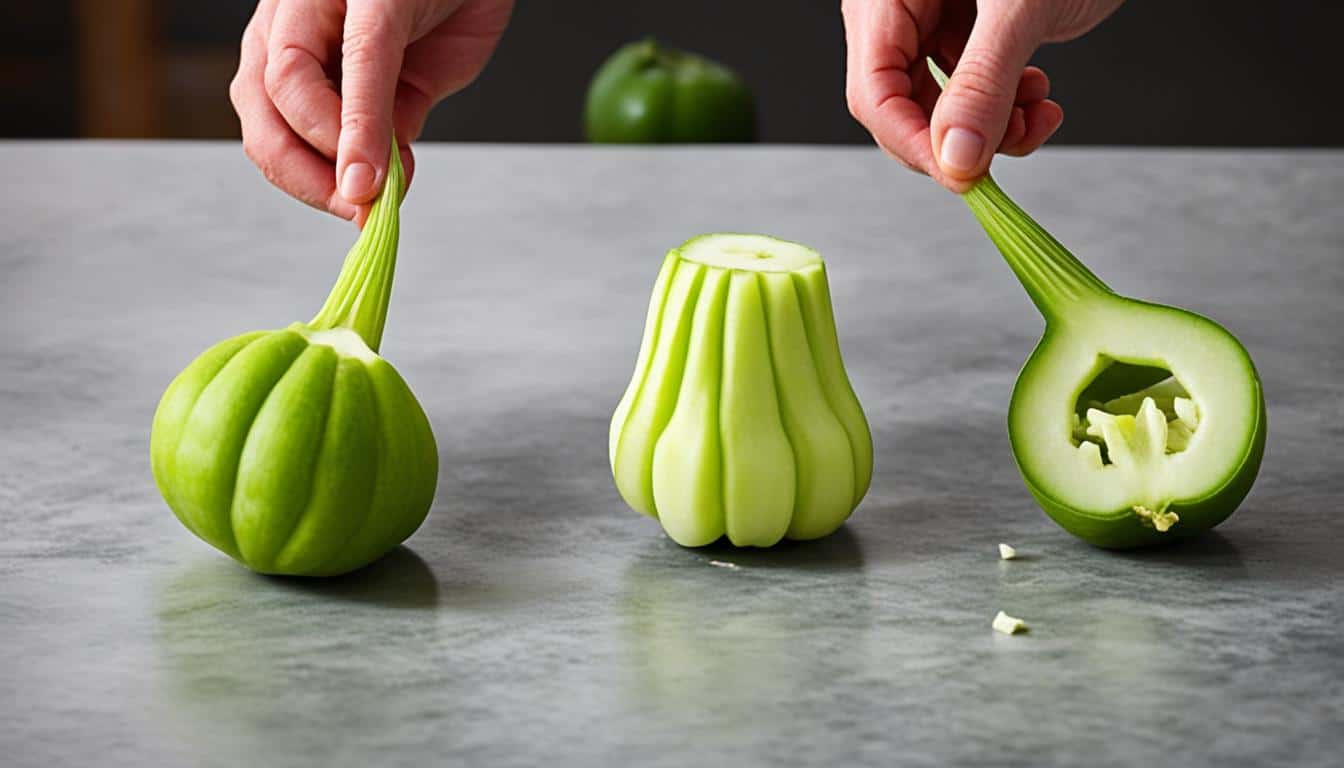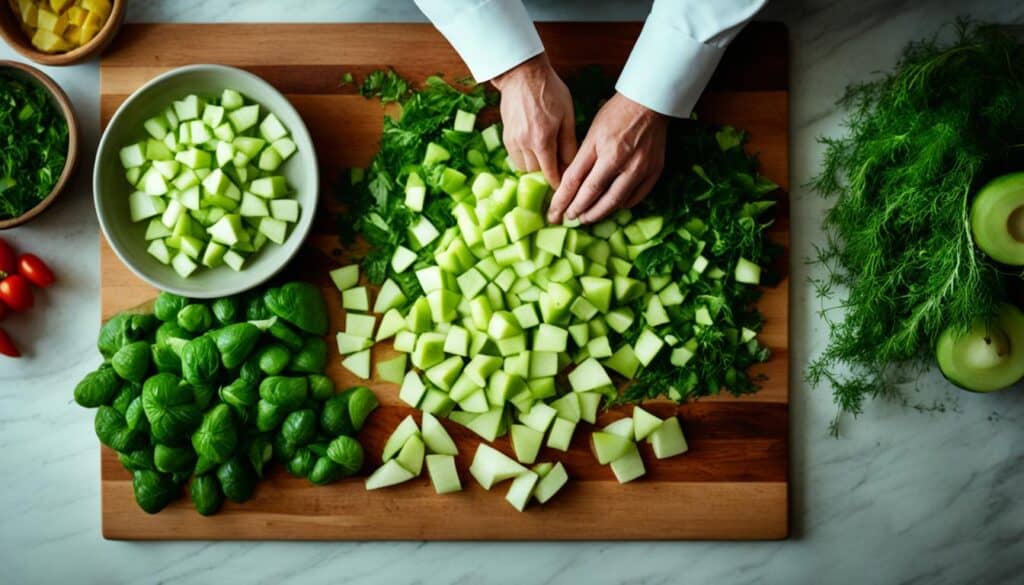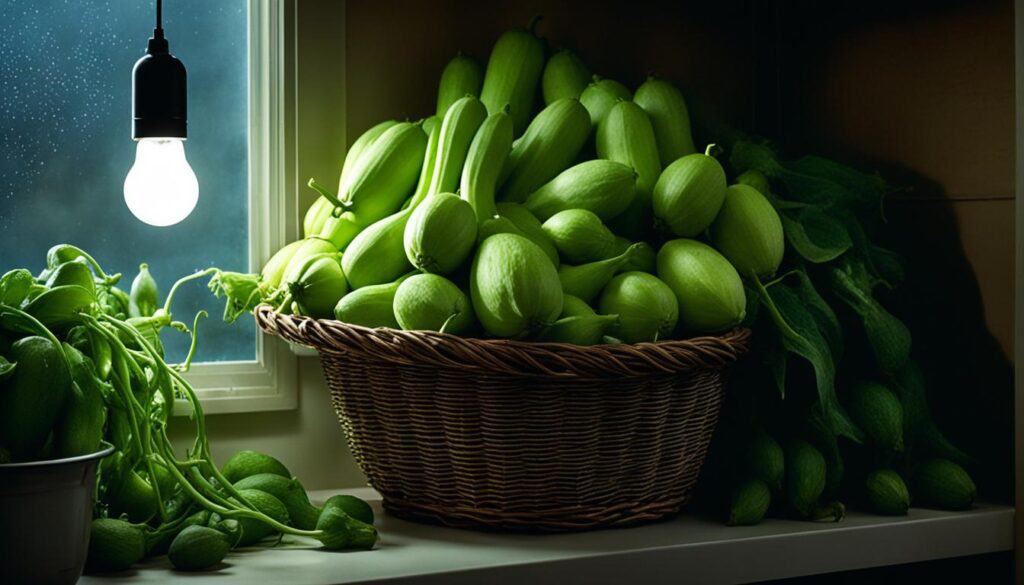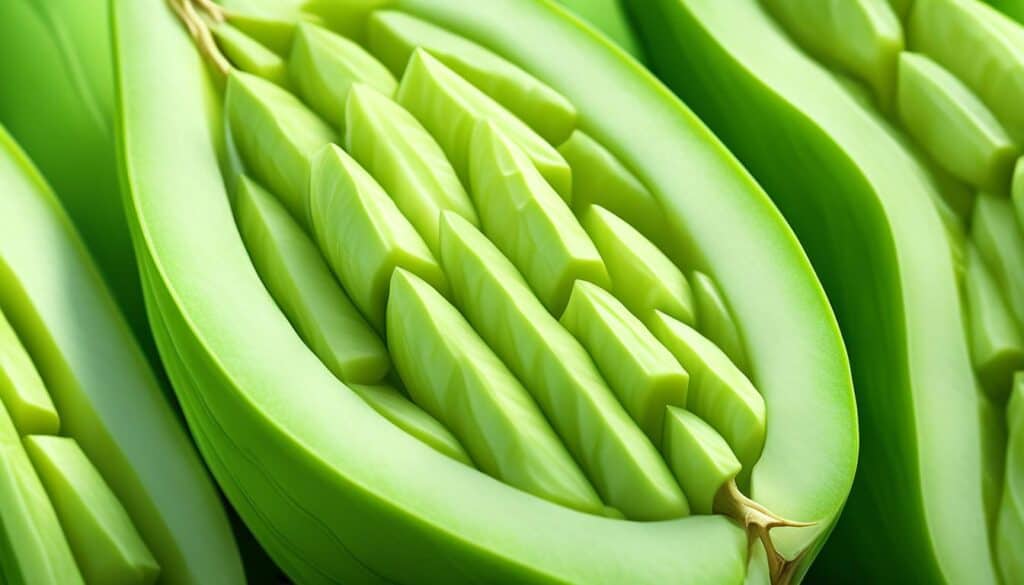Did you know that chayote squash, also known as choko or mirliton, is not only delicious but also offers a plethora of health benefits? This versatile vegetable has gained popularity in various cuisines around the world, thanks to its mild flavor and crisp texture.
In this culinary guide, I will take you on a journey to explore the different cooking techniques for chayote squash, share some mouthwatering recipes, and delve into its nutritional value. Whether you’re a seasoned chef or a curious home cook, chayote squash is an ingredient that will elevate your dishes and impress your taste buds.
So, let’s dive in and discover the wonders of chayote squash together!
Key Takeaways:
- Chayote squash is a versatile vegetable with a mild flavor and crisp texture.
- It can be cooked using various techniques, such as roasting, sauteing, stir-frying, grilling, and stuffing.
- Chayote squash can be used in a wide range of recipes, including Asian stir-fries, Mexican stuffed chayote, and salads.
- It is a nutritious vegetable, rich in fiber, vitamins, and minerals, contributing to overall health and well-being.
- You can find chayote squash in grocery stores and ethnic markets, especially during its peak season from late summer to early winter.
What is Chayote Squash?
Chayote squash, also known as vegetable pear or mirliton, is a vibrant green vegetable that belongs to the gourd family. It is native to Central and South America and has become popular in Asian and Latin American cuisines.
The entire chayote squash is edible, including the peel and seed. With its mild flavor and crisp, crunchy texture, chayote squash adds a delightful touch to dishes. Whether it’s used in a refreshing salad, sautéed in a stir-fry, or baked in a casserole, chayote squash is a versatile ingredient that can elevate any meal.
Chayote squash is not only delicious but also packed with nutrients. It is a rich source of fiber, vitamins, and minerals, making it a nutritious addition to your diet.
Discover more about the chayote plant in the following section, where we delve into how to prepare and cook this versatile vegetable.
How to Prepare Chayote Squash
Preparing chayote squash is a simple and easy process. While the peel of the chayote squash is edible, many recipes suggest peeling it as the skin can be slightly tougher than the flesh. Here’s a step-by-step guide on how to prepare chayote squash:
- Peel: Begin by peeling the chayote squash using a knife or vegetable peeler. This will remove the outer skin and expose the crisp flesh.
- Cut: Once peeled, cut the chayote squash in half lengthwise.
- Remove the Seed: Use a spoon or knife to carefully remove the seed from each chayote squash half. The seed can be easily scooped out.
- Chop: Finally, chop the chayote squash according to the instructions of your chosen recipe. This can be done into cubes, slices, or any shape required by your dish.
Chayote squash can be enjoyed raw, adding a crisp and refreshing element to salads. However, it is also delicious when cooked using various techniques, bringing out its natural flavors and enhancing its texture.
Quote:
“Preparing chayote squash is a breeze! With a few simple steps, you can transform this versatile vegetable into a delicious addition to your meals.”
| Cooking Methods | Description |
|---|---|
| Roasting | Brings out the natural sweetness of chayote squash while adding a caramelized flavor. |
| Sautéing | Quick and easy method that results in a mellow and subtly sweet flavor. |
| Stir-frying | Popular in Asian cuisine, this technique creates a crunchy and tender chayote squash. |
| Grilling | Infuses chayote squash with a delightful smoky flavor, perfect for summertime cookouts. |
| Stuffing | A traditional practice in Mexican cuisine, stuffing chayote squash with various fillings adds depth and complexity to your dishes. |
| Boiling | Great for soups, stews, or as a side dish, boiling chayote squash retains its natural flavors and nutrients. |
| Pickling | Pickled chayote squash adds a tangy and crunchy element to salads and sandwiches. |
Cooking Techniques for Chayote Squash
When it comes to cooking chayote squash, there is a wide range of techniques to choose from. Each method brings out different flavors and textures, allowing you to experiment and create delicious dishes. Here are some popular cooking techniques for chayote squash:
1. Roasting
Roasting chayote squash is a great way to enhance its natural sweetness while adding a touch of caramelization. To roast chayote squash, cut it into wedges or cubes, drizzle with olive oil, sprinkle with your favorite spices, and roast in the oven until tender. The result is a deliciously sweet and slightly nutty flavor that pairs well with a variety of seasonings.
2. Sauteing
Sauteing chayote squash is a quick and easy method that brings out its mellow and sweet flavor. Simply heat some oil or butter in a pan, add sliced or cubed chayote, and cook until tender. You can season it with herbs, spices, or a squeeze of lemon juice to enhance the flavor. Sauteed chayote squash makes a wonderful side dish or can be added to stir-fries and salads.
3. Stir-frying
Stir-frying chayote squash is a popular technique in Asian cuisines. It results in a crunchy yet tender vegetable addition to your dishes. Start by cutting the chayote into thin strips or bite-sized pieces. Heat some oil in a wok or skillet, add the chayote, and stir-fry for a few minutes until crisp-tender. You can add other vegetables, sauces, or protein to create a flavorful stir-fry.
4. Grilling
Grilling chayote squash gives it a smoky flavor and a slightly charred texture. Cut the chayote in half lengthwise, brush with oil, and place it on a preheated grill. Cook for a few minutes on each side until grill marks appear and the squash is tender. Grilled chayote squash can be enjoyed on its own, added to salads, or used as a filling for sandwiches and wraps.
5. Stuffing
Stuffing chayote squash with various fillings is a common practice in Mexican cuisine. Cut the chayote in half lengthwise, scoop out the seeds, and fill the cavity with your choice of ingredients such as ground meat, cheese, or vegetables. Bake until the filling is cooked and the chayote is tender. The result is a flavorful and satisfying dish that can be served as a main course or a side dish.
6. Boiling and Pickling
In addition to the above techniques, chayote squash can also be boiled or pickled for use in salads and side dishes. When boiling chayote, peel and cut it into desired shapes, then cook it in boiling salted water until tender. Once cooked, it can be used in salads or marinated for pickling.
Overall, these cooking techniques provide a variety of flavors and textures when preparing chayote squash. Whether you prefer roasted, sautéed, stir-fried, grilled, stuffed, boiled, or pickled chayote squash, each method offers a unique culinary experience. Experiment with different techniques and seasonings to create your own delicious chayote squash dishes.
| Technique | Flavor/Texture | Best Used For |
|---|---|---|
| Roasting | Sweet, slightly nutty, caramelized | Side dish, main course, puree, sauce |
| Sautéing | Mellow, sweet | Side dish, stir-fries, salads |
| Stir-frying | Crunchy, tender | Stir-fries, Asian-inspired dishes |
| Grilling | Smoky, charred | Side dish, sandwiches, wraps |
| Stuffing | Flavorful, satisfying | Main course, side dish |
| Boiling and Pickling | Tender, versatile | Salads, side dishes, pickles |
Delicious Chayote Squash Recipes
Chayote squash is a versatile ingredient that can be used to create a variety of delicious dishes. Whether you’re looking for a hearty main course or a refreshing side dish, here are some mouthwatering chayote recipes to try:
1. Chayote Salad
Enjoy a burst of fresh flavors with a crunchy chayote salad. Thinly slice chayote and combine it with crisp lettuce, cherry tomatoes, cucumber, and your favorite salad dressing. Sprinkle some toasted almonds on top for added texture.
2. Stuffed Chayote Boats
Add a creative twist to your meals with stuffed chayote boats. Cut chayote in half lengthwise and scoop out the center. Fill the hollowed chayote with a savory mixture of cooked ground meat, vegetables, and spices. Top it off with cheese and bake until golden and bubbling.
3. Chayote Soup
Warm up your taste buds with a comforting chayote soup. Sauté chayote with onions, garlic, and your choice of herbs. Add vegetable or chicken broth and simmer until the flavors meld together. For extra creaminess, blend the soup until smooth.
4. Chayote Stir-Fry
Create a quick and flavorful meal with a chayote stir-fry. Cut chayote into thin strips and stir-fry it with colorful bell peppers, snow peas, and your choice of protein. Season with soy sauce, ginger, and garlic for an Asian-inspired twist.
5. Chayote Casserole
Elevate your casserole game with the addition of chayote. Layer sliced chayote, cooked chicken or beef, and your favorite cheese in a baking dish. Top it off with a creamy sauce made with milk, flour, and spices. Bake until the cheese is melted and bubbly.
6. Chayote Dessert
Indulge your sweet tooth with a unique chayote dessert. Grate chayote and mix it with sugar, cinnamon, and a squeeze of lemon juice. Spread the mixture over a pre-made pie crust and bake until golden brown. Serve warm with a scoop of vanilla ice cream.
These are just a few examples of the many delicious chayote squash recipes you can try. Get creative in the kitchen and discover new ways to enjoy this versatile vegetable.
Storing and Handling Chayote Squash
When it comes to chayote squash, proper storage is key to maintaining its freshness and flavor. Follow these simple tips to store and handle chayote squash:
-
Refrigeration: Chayote squash can be stored in the refrigerator for up to two weeks. To keep it fresh and prevent drying out, make sure to wrap it in a plastic bag or place it in an airtight container.
-
Peeling and cutting: If you’ve peeled or cut the chayote squash, it can be stored in the refrigerator for up to 5 days. Keep it in a sealed container or wrap it tightly to maintain its freshness.
-
Cooked chayote: If you have cooked chayote squash, it’s important to store it in the refrigerator. Consume it within a few days to ensure optimal freshness and taste.
By following these storage and handling guidelines, you can enjoy the delicious taste and texture of chayote squash in your meals for an extended period.
The key to storing chayote squash:
“Properly storing chayote squash in the refrigerator helps maintain its freshness and flavor, ensuring that it lasts for up to two weeks.”
Health Benefits of Chayote Squash
Chayote squash is not only tasty but also packed with nutrients. It is low in calories and rich in fiber, vitamins, and minerals. Chayote is a good source of vitamin C, potassium, and folate. It also has antioxidant properties and may aid in digestion and promote cardiovascular health. Adding chayote squash to your diet can contribute to your overall well-being.
| Nutrient | Amount per 100g |
|---|---|
| Calories | 19 |
| Fiber | 2g |
| Vitamin C | 7mg |
| Potassium | 125mg |
| Folate | 17mcg |
Chayote squash is a great addition to a balanced diet, offering numerous health benefits. Here are some key advantages:
- Weight Management: With its low calorie content and high fiber, chayote squash can help you feel full and satisfied without adding excessive calories to your diet.
- Digestive Health: The fiber in chayote promotes a healthy digestive system by aiding in digestion and preventing constipation.
- Heart Health: Chayote squash is a good source of potassium, which helps maintain healthy blood pressure levels and supports heart function.
- Immune Support: The vitamin C content in chayote squash can boost immune function and protect against common illnesses and infections.
- Antioxidant Protection: Chayote squash contains antioxidants that fight oxidative stress and help protect cells from damage.
Including chayote squash in your meals can not only enhance their flavor and texture but also provide you with valuable nutrients that support your overall well-being.
The Versatility of Chayote Squash
Chayote squash is a versatile vegetable that can be used in various cuisines and dishes. Its adaptability makes it a popular choice for cooks around the world. Whether you’re a fan of Asian stir-fries, Mexican stuffed chayote recipes, or looking to add a refreshing twist to your salads, chayote is the ingredient to consider.
The mild flavor of chayote squash allows it to pair well with a wide range of flavors and ingredients. Its crisp texture adds a delightful crunch to both savory and sweet dishes. From soups and stews to casseroles and desserts, chayote squash can be used in countless ways to elevate the taste and texture of your recipes.
Chayote in Different Cuisines
Asian cuisines, such as Thai, Chinese, and Vietnamese, often feature chayote squash in stir-fries and noodle dishes. Its versatility allows it to absorb the flavors of the accompanying ingredients, creating a harmonious blend of tastes.
“Chayote squash brings a delightful crunch to my favorite Thai stir-fry. It pairs perfectly with the vibrant spices and sauces, adding both texture and flavor to the dish.”
-Chen L., Thai cuisine enthusiast
In Mexican cuisine, chayote squash is commonly used in stuffed chayote recipes. The hollowed-out squash is filled with a flavorful mixture of meat, rice, and vegetables, then baked to perfection. Its subtle taste allows the fillings to shine, creating a delicious and satisfying meal.
“Stuffed chayote is a classic Mexican dish that my family enjoys. The tender squash holds the savory filling beautifully, and each bite is a burst of rich flavors.”
-Maria G., Mexican food enthusiast
Chayote squash is also a fantastic addition to salads. Its crispness gives salads a refreshing crunch, and its mild flavor complements a variety of dressings and ingredients. Whether you’re making a simple green salad or a more elaborate fruit and vegetable medley, chayote squash adds a unique twist that will impress your taste buds.
“I love adding chayote squash to my salads. Its texture adds a delightful contrast, and the subtle taste complements the other ingredients perfectly!”
-Emily T., salad lover
Incorporate chayote squash into your favorite recipes and explore its potential in different cuisines. Its versatility will inspire you to get creative in the kitchen and elevate your culinary creations.
Where to Find Chayote Squash
If you’re looking to buy chayote squash, you’re in luck! This versatile vegetable can be found in many grocery stores and ethnic markets. Here are some tips on where to find fresh chayote and ensure you’re getting the best quality:
1. Grocery Stores
Check out the produce section of your local grocery store. Chayote squash is often stocked alongside other fruits and vegetables. Look for firm squash with a bright green color, and avoid any chayote with blemishes or soft spots.
2. Ethnic Markets
Explore ethnic markets in your area, particularly those that specialize in Asian or Latin American ingredients. These markets often carry a wide variety of fresh produce, including chayote squash. Don’t hesitate to ask the store staff for assistance in finding chayote if you’re having trouble locating it.
3. Seasonal Availability
Chayote squash is most commonly available during its peak season, which is from late summer to early winter. Keep an eye out for it during this time, as it will be more readily available and at its freshest.
If you’re unable to find fresh chayote squash, don’t worry! You may still be able to enjoy this vegetable by looking for canned or frozen chayote in some stores. These alternatives can be a convenient option when fresh chayote is not readily available.
With these tips in mind, you’ll be well-equipped to find chayote squash and incorporate it into your culinary creations. Happy cooking!
Conclusion
Chayote squash is a versatile and nutritious vegetable that can elevate your meals with its distinct flavor and satisfying texture. Whether you’re a culinary explorer or a kitchen experimenter, chayote squash is a must-have ingredient in your pantry. Its vibrant green color and mild taste make it a perfect addition to various international cuisines and a wide range of recipes.
From roasting to sautéing, there are countless cooking techniques that bring out the best in chayote squash. Its crisp and crunchy texture shines through when stir-fried, while roasting enhances its inherent sweetness. With its ability to absorb flavors, chayote squash can be a versatile canvas for your culinary creations, allowing you to infuse it with your favorite seasonings and spices.
Thanks to its low calorie content and high fiber, vitamin, and mineral content, chayote squash is not only delicious but also contributes to a healthy diet. Packed with vitamins C and folate, as well as potassium, chayote squash supports your well-being and can be a valuable addition to a balanced meal plan. So why not introduce this nutritious and versatile vegetable into your cooking repertoire? Try out some chayote squash recipes and let your taste buds be pleasantly surprised!










Leave a Reply